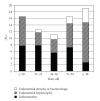Office hysteroscopy for infertility: a series of 557 consecutive cases
- PMID: 20396413
- PMCID: PMC2855076
- DOI: 10.1155/2010/168096
Office hysteroscopy for infertility: a series of 557 consecutive cases
Abstract
Objective. To study incidence of abnormal hysteroscopic findings according to age. Methods. We retrospectively studied 557 consecutive office hysteroscopies in patients referred for incapacity to conceive lasting at least 1 year or prior to in vitro fertilization. Rates of abnormal findings were reviewed according to age. Results. In 219 cases, hysteroscopy showed an abnormality and more than a third of our population had abnormal findings that could be related to infertility. Rates of abnormal findings ranged from 30% at 30 years to more than 60% after 42 years. Risk of abnormal finding was multiplied by a factor of 1.5 every 5 years. Conclusion. Our data are an additional argument to propose office hysteroscopy as part of first-line exams in infertile woman, regardless of age.
Figures




Similar articles
-
Office mini-hysteroscopy.Hum Reprod Update. 1999 Jan-Feb;5(1):73-81. doi: 10.1093/humupd/5.1.73. Hum Reprod Update. 1999. PMID: 10333371 Review.
-
Office hysteroscopy in an in vitro fertilization program.Gynecol Endocrinol. 2008 Aug;24(8):465-9. doi: 10.1080/09513590802246232. Gynecol Endocrinol. 2008. PMID: 18850385
-
1000 office-based hysteroscopies prior to in vitro fertilization: feasibility and findings.JSLS. 2004 Apr-Jun;8(2):103-7. JSLS. 2004. PMID: 15119651 Free PMC article.
-
Pregnancy rates after hysteroscopic polypectomy depending on the size or number of the polyps.Arch Gynecol Obstet. 2008 May;277(5):395-9. doi: 10.1007/s00404-007-0460-z. Epub 2007 Sep 13. Arch Gynecol Obstet. 2008. PMID: 17851673
-
Office Operative Hysteroscopy: An Update.J Minim Invasive Gynecol. 2018 Feb;25(2):199-208. doi: 10.1016/j.jmig.2017.08.009. Epub 2017 Aug 10. J Minim Invasive Gynecol. 2018. PMID: 28803811 Review.
Cited by
-
Uterine cavity assessment in infertile women: Sensitivity and specificity of three-dimensional Hysterosonography versus Hysteroscopy.Iran J Reprod Med. 2013 Dec;11(12):977-82. Iran J Reprod Med. 2013. PMID: 24639723 Free PMC article.
-
Pregnancy Outcome after Office Microhysteroscopy in Women with Unexplained Infertility.Int J Fertil Steril. 2015 Jul-Sep;9(2):168-75. doi: 10.22074/ijfs.2015.4237. Epub 2015 Jul 27. Int J Fertil Steril. 2015. PMID: 26246874 Free PMC article.
-
Diagnostic hysteroscopy - a retrospective study of 1545 cases.Maedica (Bucur). 2012 Dec;7(4):309-14. Maedica (Bucur). 2012. PMID: 23483793 Free PMC article.
-
Diagnostic and therapeutic hysteroscopy in Ethiopia: a retrospective study on practice and outcomes.BMC Womens Health. 2024 Dec 21;24(1):656. doi: 10.1186/s12905-024-03481-6. BMC Womens Health. 2024. PMID: 39709420 Free PMC article.
-
Placental mesenchymal stem cell-derived exosomes treat endometrial injury in a rat model of intrauterine adhesions.Mol Genet Genomics. 2025 Mar 25;300(1):36. doi: 10.1007/s00438-025-02241-x. Mol Genet Genomics. 2025. PMID: 40128387 Free PMC article.
References
-
- Golan A, Eilat E, Ron-El R, Herman A, Soffer Y, Bukovsky I. Hysteroscopy is superior to hysterosalpingography in infertility investigation. Acta Obstetricia et Gynecologica Scandinavica. 1996;75(7):654–656. - PubMed
-
- Rowe PC, Hargreave T, Mellows H. WHO Manual for the Standardized Investigation and Diagnosis of the Infertile Couple. Cambridge, UK: The Press Syndicate of the University of Cambridge; 1993.
-
- de Sa Rosa e de Silva AC, Rosa e Silva JC, Candido dos Reis FJ, Nogueira AA, Ferriani RA. Routine office hysteroscopy in the investigation of infertile couples before assisted reproduction. Journal of Reproductive Medicine for the Obstetrician and Gynecologist. 2005;50(7):501–506. - PubMed
-
- Balmaceda JP, Ciuffardi I. Hysteroscopy and assisted reproductive technology. Obstetrics and Gynecology Clinics of North America. 1995;22(3):507–518. - PubMed
-
- Valle RF. Hysteroscopy in the evaluation of female infertility. American Journal of Obstetrics and Gynecology. 1980;137(4):425–431. - PubMed
LinkOut - more resources
Full Text Sources

